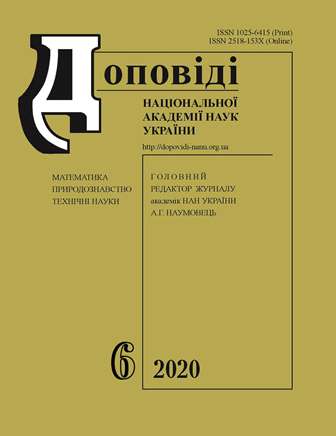Азометинові похідні п-амінобензойної кислоти як антиоксиданти та інгібітори ксантиноксидази
DOI:
https://doi.org/10.15407/dopovidi2020.06.074Ключові слова:
інгібування, азометини, антиоксидантні властивості, гідроксильні радикали, ксантиноксидаза, молекулярний докінгАнотація
Встановлено антиоксидантні властивості гідроксильованих азометинових похідних п-амінобензойної кис лоти та інгібувальний вплив цих сполук на активність ксантиноксидази. Аналіз інгібувальної активнос ті серії синтезованих азометинових сполук щодо ксантиноксидази, а також результати молекулярного до кінгу вказують на те, що в механізмах інгібування ферменту можуть бути задіяні карбоксильна і гідроксильна групи. Вплив азометинових похідних описується кінетикою змішаного типу з мікромолярними значеннями констант інгібування. Інгібувальна здатність найактивнішої сполуки, 4-(((1E)-(2-гідрокси-5- нітрофеніл)метилен)аміно)бензойної кислоти, співмірна з впливом відомого інгібітора — алопуринолу. Молекулярний докінг азометинового інгібітора в активний центр ксантиноксидази свідчить про те, що карбоксилатна група утворює водневі зв’язки з амінокислотними залишками Arg880, Thr1010 і Glu1261, а гідроксильна група наближена до залишків Glu802 і Asn768. Крім того, арильні фрагменти молекули інгібітора фор мують контакти із Phe914, Phe1009, Leu648, Phe1013 та іншими залишками. Антиоксидант ні властивості азометинів оцінено в модельній системі шляхом визначення малонового діальдегіду в тесті з тіобарбіту ровою кислотою. Показано, що здатність деяких сполук нейтралізувати гідроксильні радикали перевищує дію тролоксу як еталонного антиоксиданту.
Завантаження
Посилання
Pacher, P., Nivorozhkin, A. & Szabó, C. (2006). Therapeutic effects of xanthine oxidase inhibitors: renaissance half a century after the discovery of allopurinol. Pharmacol. Rev., 58, No. 1, pp. 87-114. https://doi.org/10.1124/pr.58.1.6
Voelker, R. (2019). Another warning for febuxostat. JAMA. 321, No. 13, pp. 1245. https://doi.org/10.1001/jama.2019.3043
Prakash, A. & Adhikari, D. (2011). Application of Schiff bases and their metal complexes-A review. Int. J. Chem. Tech. Res., 3, No. 4, pp. 1891-1896.
Paşa, S., Tuneğ, M. & Boğa, M. (2019). Biological surveying of diverse Schiff base compounds: antiproliferative, antiradical and enzyme inhibition activity. Pharm. Chem. J., 53, No. 4, pp. 302-311. https://doi.org/10.1007/s11094-019-01997-y
Ali, Z. Y., Mohamed, S. A. & Edrees, M. M. (2012). Biological screening for some newly synthesized pyrazolo[3, 4-d]pyrimidine derivatives. Nat.Sci., 10, No. 7, pp. 58-69.
Titinchia, S. J. J., Abbo, H. S. & Saeed, A. A. H. (2004). Synthesis, spectroscopic and molecular structures investigations of some carboxylated schiff bases. J. Mol. Struct., 705, No. 1-3, pp. 121-126. https://doi.org/10.1016/j.molstruc.2004.06.025
Aruoma, O. I. (1994). Deoxyribose assay for detecting hydroxyl radicals. Methods Enzymol., 233, pp. 57-66. https://doi.org/10.1016/S0076-6879(94)33008-5
Manchot, W. & Furlong, J. R. (1909). Über Isomerie bei Anilen (Schiffschen Basen). (2. Mitteilung). Chem. Ber., 42, No. 3030, pp. 4383-4389. https://doi.org/10.1002/cber.19090420429
Khan, M. I., Khan, A., Hussain, I., Khan, M. A., Gul, S., Iqbal, M., Rahman, I.-U. & Khuda, F. (2013). Spectral, XRD, SEM and biological properties of new mononuclear Schiff base transition metal complexes. Inorg. Chem. Commun., 35, pp. 104-109. https://doi.org/10.1016/j.inoche.2013.06.014
Exner, O. & Lakomý, J. (1970). Studies on the inductive effect. VII. Inductive and mesomeric effects of nitrogen and oxygen substituents. Collect. Czech. Chem. Commun., 35, pp. 1371-1386. https://doi.org/10.1135/cccc19701371
Dikusar, A. E. (2012). Synthesis of (E)-2-methoxy-6-(R-imino)methylphenols and 2-methoxy-6-(R-amino) methylphenols. Rus. J. Gen. Chem., 82, No. 4, pp. 693-696. https://doi.org/10.1134/S1070363212040159
Cronenberger, L., Gaige, T., Pacheco, H. & Pillon, D. (1968). Nouvelles bases de Schiff dérivées des aldehydes dihalogéno-3,5 salicyliques et possédant des propriétés antifongiques et antibactériennes. Chim. Ther., 3, No. 2, pp. 87-99
Jiayi, S., Min, Z. & Changyan, S. (2019). A highly selective fluorescent chemosensor for Al(III) ions based on 2-hydroxy-1-naphthaldehyde derivative. Can. J. Chem., 97, No. 5, pp. 387-391. https://doi.org/10.1139/cjc-2018-0141
Brewster, C. M. & Millam, L. H. (1933). Phototropic and thermotropic anils from 5-bromosalicylaldehyde. J. Am. Chem. Soc., 55, No. 2, pp. 763-766. https://doi.org/10.1021/ja01329a049
Muzychka, O. V., Kobzar, O. L., Popova, A. V., Frasinyuk, M. S. & Vovk, A. I. (2017). Carboxylated aurone derivatives as potent inhibitors of xanthine oxidase. Bioorg. Med. Chem., 25, No. 14, pp. 3606-3613. https://doi.org/10.1016/j.bmc.2017.04.048
##submission.downloads##
Опубліковано
Як цитувати
Номер
Розділ
Ліцензія
Авторське право (c) 2023 Доповіді Національної академії наук України

Ця робота ліцензується відповідно до Creative Commons Attribution-NonCommercial 4.0 International License.




